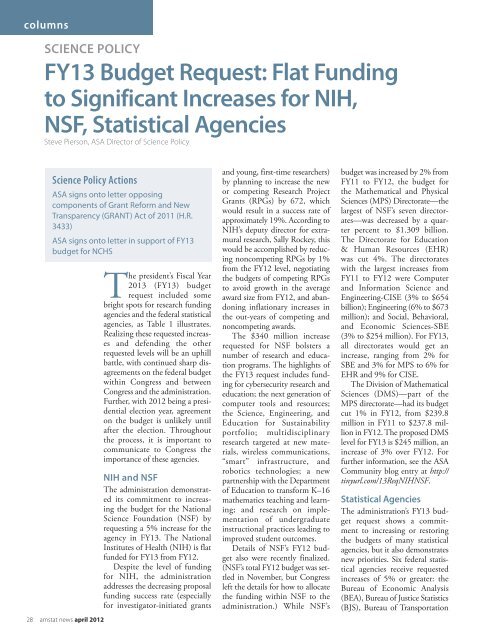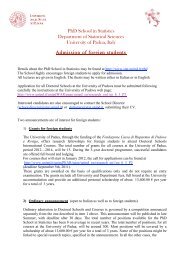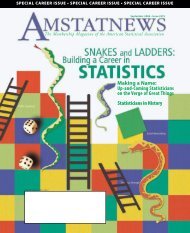Amstat News - American Statistical Association
Amstat News - American Statistical Association
Amstat News - American Statistical Association
Create successful ePaper yourself
Turn your PDF publications into a flip-book with our unique Google optimized e-Paper software.
columns<br />
SCIENCE POLICY<br />
FY13 Budget Request: Flat Funding<br />
to Significant Increases for NIH,<br />
NSF, <strong>Statistical</strong> Agencies<br />
Steve Pierson, ASA Director of Science Policy<br />
Science Policy Actions<br />
ASA signs onto letter opposing<br />
components of Grant Reform and New<br />
Transparency (GRANT) Act of 2011 (H.R.<br />
3433)<br />
ASA signs onto letter in support of FY13<br />
budget for NCHS<br />
28 amstat news april 2012<br />
The president’s Fiscal Year<br />
2013 (FY13) budget<br />
request included some<br />
bright spots for research funding<br />
agencies and the federal statistical<br />
agencies, as Table 1 illustrates.<br />
Realizing these requested increases<br />
and defending the other<br />
requested levels will be an uphill<br />
battle, with continued sharp disagreements<br />
on the federal budget<br />
within Congress and between<br />
Congress and the administration.<br />
Further, with 2012 being a presidential<br />
election year, agreement<br />
on the budget is unlikely until<br />
after the election. Throughout<br />
the process, it is important to<br />
communicate to Congress the<br />
importance of these agencies.<br />
NIH and NSF<br />
The administration demonstrated<br />
its commitment to increasing<br />
the budget for the National<br />
Science Foundation (NSF) by<br />
requesting a 5% increase for the<br />
agency in FY13. The National<br />
Institutes of Health (NIH) is flat<br />
funded for FY13 from FY12.<br />
Despite the level of funding<br />
for NIH, the administration<br />
addresses the decreasing proposal<br />
funding success rate (especially<br />
for investigator-initiated grants<br />
and young, first-time researchers)<br />
by planning to increase the new<br />
or competing Research Project<br />
Grants (RPGs) by 672, which<br />
would result in a success rate of<br />
approximately 19%. According to<br />
NIH’s deputy director for extramural<br />
research, Sally Rockey, this<br />
would be accomplished by reducing<br />
noncompeting RPGs by 1%<br />
from the FY12 level, negotiating<br />
the budgets of competing RPGs<br />
to avoid growth in the average<br />
award size from FY12, and abandoning<br />
inflationary increases in<br />
the out-years of competing and<br />
noncompeting awards.<br />
The $340 million increase<br />
requested for NSF bolsters a<br />
number of research and education<br />
programs. The highlights of<br />
the FY13 request includes funding<br />
for cybersecurity research and<br />
education; the next generation of<br />
computer tools and resources;<br />
the Science, Engineering, and<br />
Education for Sustainability<br />
portfolio; multidisciplinary<br />
research targeted at new materials,<br />
wireless communications,<br />
“smart” infrastructure, and<br />
robotics technologies; a new<br />
partnership with the Department<br />
of Education to transform K–16<br />
mathematics teaching and learning;<br />
and research on implementation<br />
of undergraduate<br />
instructional practices leading to<br />
improved student outcomes.<br />
Details of NSF’s FY12 budget<br />
also were recently finalized.<br />
(NSF’s total FY12 budget was settled<br />
in November, but Congress<br />
left the details for how to allocate<br />
the funding within NSF to the<br />
administration.) While NSF’s<br />
budget was increased by 2% from<br />
FY11 to FY12, the budget for<br />
the Mathematical and Physical<br />
Sciences (MPS) Directorate—the<br />
largest of NSF’s seven directorates—was<br />
decreased by a quarter<br />
percent to $1.309 billion.<br />
The Directorate for Education<br />
& Human Resources (EHR)<br />
was cut 4%. The directorates<br />
with the largest increases from<br />
FY11 to FY12 were Computer<br />
and Information Science and<br />
Engineering-CISE (3% to $654<br />
billion); Engineering (6% to $673<br />
million); and Social, Behavioral,<br />
and Economic Sciences-SBE<br />
(3% to $254 million). For FY13,<br />
all directorates would get an<br />
increase, ranging from 2% for<br />
SBE and 3% for MPS to 6% for<br />
EHR and 9% for CISE.<br />
The Division of Mathematical<br />
Sciences (DMS)—part of the<br />
MPS directorate—had its budget<br />
cut 1% in FY12, from $239.8<br />
million in FY11 to $237.8 million<br />
in FY12. The proposed DMS<br />
level for FY13 is $245 million, an<br />
increase of 3% over FY12. For<br />
further information, see the ASA<br />
Community blog entry at http://<br />
tinyurl.com/13ReqNIHNSF.<br />
<strong>Statistical</strong> Agencies<br />
The administration’s FY13 budget<br />
request shows a commitment<br />
to increasing or restoring<br />
the budgets of many statistical<br />
agencies, but it also demonstrates<br />
new priorities. Six federal statistical<br />
agencies receive requested<br />
increases of 5% or greater: the<br />
Bureau of Economic Analysis<br />
(BEA), Bureau of Justice Statistics<br />
(BJS), Bureau of Transportation




